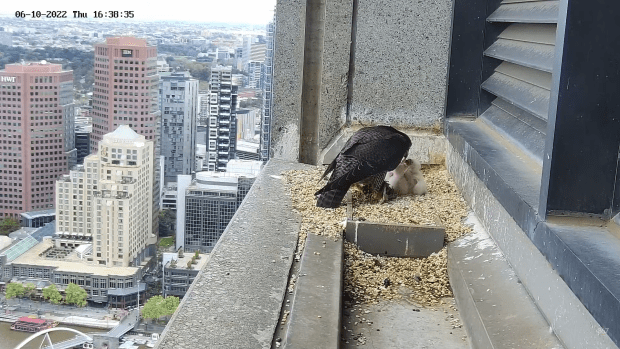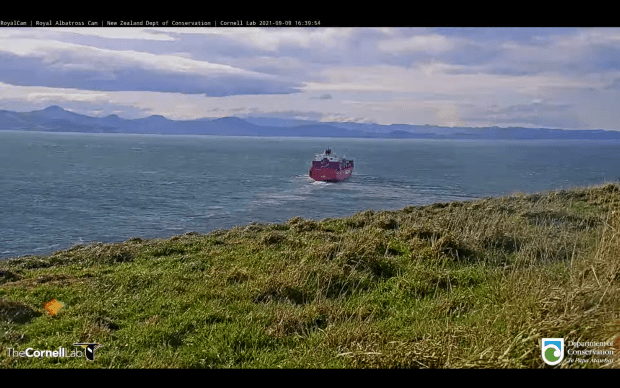6 October 2022
Good Morning Everyone,
Oh, goodness. One area of my City had its first snow last evening and the temperature for the rest of us is 1 degree C. (Think of 0 as 32 degrees F). We had our first heavy frost last night. This cold snap will surely put some of the birds that are arriving in our City on a path south!
The active nests remain in Australia while the Bald Eagles work on their nests for egg laying later in the year in the US. Rain is the issue at some of the nests. Melbourne received 3 inches of rain or 7.5 cm. Mum worked so hard to keep those eyases dry. Sadly, the Collins Street scrape will have more rain today – perhaps an inch – starting at around 0800. My weather report says that should end around 1300. It has really rained in Sydney and there are some areas that are flooding. Rain should begin in the Olympic Park where the Ironwood Tree nest of the Sea Eagles is located at around 1100 and then stop. Port Lincoln could be dry today! Yippee. It looks right now that Orange could be dry as well. We wait and see how the forecasts hold up BUT regardless, these amazing raptor families are doing well despite the heavy downpours that are occurring. That is simply wonderful.
There is word that Friends of Osprey – think Janet Foster, Ian Falkenburg, Fran Solly – from Port Lincoln and all those who donated or joined Friends of Osprey – have received four sat pack transmitters for this year. There will be one available for Port Lincoln and one each going to the three other nests should they have fledglings. Calypso has been seen numerous times and is flying well. She is the 2019 fledgling from PLO. Ervie is, of course, out and about being the man about town in Port Lincoln. This is excellent news. More platforms are planned for South Australia as well as the number of Ospreys grow in the area.
Friends of Ospreys has a new website and they are grateful for all donations. All funds go directly to the camera, etc at Port Lincoln, new platforms in the area, and those precious transmitters. This is their new site and it is packed with information. Not a member? Consider donating. Membership is $20 Australian.
Here is the latest news from the blog on our darling Ervie:
https://friendsofosprey.com.au/our-tracked-osprey/
An announcement came out of the Royal Albatross Centre on Taiaroa Head yesterday that a decision was made and accepted by all members that the Royal Cam Chick known as QT be officially named ‘Lillibet’ after Queen Elizabeth II.

I was worried about Little Bob at Port Lincoln yesterday. Big and Middle continue to go at one another and well, I will sound like a broken record but, it is a real blessing that they stop fighting and act nicely at the fish table. ‘A’ noticed yesterday that Little Bob’s lack of a long neck is hampering him if he is not at the right position during feeding. That said, he walked away with several nice size crops later yesterday when larger fish came to the nest.


In the image below, have a look at Middle Bob. Notice the dark woolier down that is now replacing that light grey coat of down the osplets had when they hatched. They will retain this thermal wooly layer to help them regulate their temperature. Feathers will begin to appear. You can already see the rusty-gold ones on their head and nape. These will be followed by the wing, tail, and body feathers until they get their full juvenile plumage. They are going to be very itchy and will spend much time preening.
Remember that the feathers are often called ‘blood feathers’. The feathers grow from blood quills which will disintegrate and fall off as the feathers grow.

Little Bob looks great with that big crop of his. You will notice that all three chicks are in the full reptilian phase including having ‘clown feet’.
We all wondered if Little Bob would be another Ervie. He certainly does his best to get up front and at the beak for feeding. The beaking between the two older siblings does send him into safe positions and it does appear that he is often afraid of them — and for good reason. He is still very small. Let the older more evenly matched siblings take their angst out on one another!



Dad continues to provide lots of prey for the Melbourne eyases and he does his best to feed them and keep them covered from the sun. It is difficult for him to brood them – even last year, Old Dad has a huge problem when it came to four chicks. They all seem to be doing well including the smallest one.

Mum has been notified that prey is delivered. She has flown off to have a break and eat.

Dad arrives and stays with the eyases til Mum returns.


Some chatting and bowing and Dad is off!


The older chicks can see well. It is hard to determine if the 4th has its eyes fully open and focused yet. Oh, how I wish there was a zoom on that camera!



The wee one at Orange is getting some food while Big Bob is growing like crazy. Everything is going well at Orange for Xavier and Diamond and we will all get to see how these two manage as parents of two this year instead of one.
There have been lots of feedings and Xavier has been able to feed and brood his family! He so loves being such an active part in everything instead of just providing prey.



SE30 has not fledged yet. The heavy rains in the forest should slow down any flying but, SE29 does not seem to be bothered flying in and out of the nest. SE29 is roosting elsewhere. SE30 is so excited to see its sibling when it flies in. They seem to have such a special bond with one another this year.
Fish have been coming to the nest and Lady often feeds SE30 and also SE29 should s/he show up on the nest. SE29 is often more interested in what is going around making one wonder if s/he is not also being fed elsewhere.




All of the nests are as quiet as they can be in the middle of the night in Australia. Despite the weather, all of the parents are able to feed and keep their little and not so little youngsters fed and warm (if needed).
Migration:
Checking on Karl II family for 5 October. Bonus continues to stay in the same area of Romania. Tracking shows that he flew a lot. This is a map of where he is and an image of the area.



Waba is still in Moldova at an area around Glodeni.


Waba seems to be enjoying a pond in the landscape. You can see by the blue dots that he visits there often. How wonderful he has found a source of fish and frogs.

Karl II has just astounded people with a 450 km flight. He is now in Turkey!


I see that there are no tracking reports yet for Kaia. On 4 October she was 31 km from the Mediterranean Sea. She is perhaps in areas where there is little satellite transmissions available.
Don’t forget that 8 October is Big Bird Day at Cornell Bird Lab. Go to their website to register for the bird count if you are not already a part of eBird. It is free. Here is the information to get you started:
https://ebird.org/news/october-big-day-2022
Thank you so much for joining me this morning. Take care. See you soon!
Thank you to the following for their streaming cams and posts where I took my screen captures: Friends of Osprey, Cornell Bird Lab and NZ DOC, Port Lincoln Ospreys, 367 Collins Street by Mirvac, Charles Sturt Falcon Cam, Sea Eagles@Birdlife Australia Discovery Centre Sydney Olympic Park, and Looduskalender Forum.

























































































